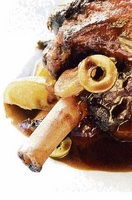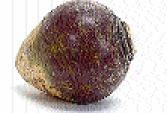Nutritious root vegetables
Published: Saturday | July 11, 2009

Though Jamaicans often use beet in drink, it can also provide a flavourful spin on meat dishes.
We remember how we detested our mothers when they insisted that we "eat up your vegetables" at mealtime. We were given the green, leafy vegetables and the red and orange ones in salads which we considered "rabbit food" then, but have later come to appreciate them in adult life.
Vegetables are a broad category that includes root vegetables, which have to be dug up to be reaped. There are several root vegetables, chock-full of nutrition but are hardly produced for use in the diet.
TURNIPS

The most common type of turnip is mostly white-skinned with purple, red or greenish wherever sunlight falls on them. The interior flesh is entirely white. Interestingly, turnips, which belong to the cabbage family, are underutilised with many persons only use them for soup.
Turnips have a distinct flavour when bitten and are similar to radishes but just a little milder in taste. A fair amount of vitamin C and fibre is found in turnips.
This root vegetable is a dieter's dream as turnips are free of fat with very little fibre. A member of the cruciferous family, turnips contain antioxidants which help to keep the body free from some cancers.
Selecting turnips
Turnip roots should be smooth, firm and heavy. When purchasing turnips, be sure to select those that are firm, smooth and free from blemishes.
Wax may have been applied to turnips to extend the shelf life and those turnips are safe to eat. You may purchase turnips with the green parts and these can be sautéed as a side dish. This is known as 'turnip greens'.
Vegetables have got a bad rap because they were prepared by boiling the heck out of them, causing them to lose flavour and nutrients. Unusual root vegetables can be prepared in a number of exciting ways.
Preparing turnip for cooking
Use a vegetable peeler to remove waxed skin. If unwaxed, scrub thoroughly. Turnips may be mashed and seasoned for soups and stews.
TURNIP MASHED POTATOES
6 large red new potatoes, skin on
2 large turnips, peeled
1/2 cup cream, heated
8 tablespoons butter or soft margarine, melted
1/2 cup sour cream
Salt and pepper
Method:
1. Slice potatoes and turnips 1/4-inch thick. Cook in boiling water for 15 minutes or until fork-tender. Drain.
2. Whip unpeeled cooked potatoes and turnips with electric mixer, mixing until moderately smooth. Add hot cream, butter and sour cream. Season with salt and pepper to taste.
3. Whip again until blended. Adjust thickness by adding more cream if desired.
Yields 8.
Source: FoodNetwork.com
PARSNIPS

The parsnip, an off-white carrot lookalike, was a staple food in Europe before potatoes and provide a good source for complex carbohydrates and contain little fat and no cholesterol.
This vegetable looks like a white version of the carrot root but it is not as hard or crisp as the carrot. The taste is similar to carrots but just a little sweeter. Parsnips are touted as an excellent food for diabetics and they provide a good supply of complex carbohydrates and fibre.
Parsnips are great for weight loss, lowering cholesterol and improving digestive health. Parsnips provide folate, which is good for pregnant women and they are rich in vitamin C to boost the immune system.
Selecting parsnips
1. Select small parsnips over large ones, which may be tough and fibrous. Reject those that are longer than eight inches.
2. Parsnips should be firm ad not spongy.
3. Wrap in paper towels and place in sealed plastic bags and store in the refrigerator.
4. Caution: Handling moist parsnips, followed by exposure to sunlight can trigger a rash. This allergy alert may trigger a photosensitive reaction due to photosensitising substances - called psoralens - naturally present in plants.
Preparing parsnips
Peel parsnips as you would carrots and place in water with lemon juice or vinegar immediately after peeling as oxidation causes them to turn brown. Serve in soups and stews.
RUTABAGAS
Rutabagas could be considered as a cross between the Savoy cabbage and turnips. The name is Swedish and they are often referred to as 'Swedish turnips'. Rutabagas are large, yellow-fleshed tubers with a slightly sweet taste.
Rutabagas are members of the cancer-fighting cruciferous family and are rich in vitamin C, which aids calcium and iron absorption, boosting immunity and healing wounds.
Selection of rutabagas
1. Stick to small ones as those over 6" in diameter may be tough.
2. If the rutabaga is heavy, it is a good root but if lightweight, soft and moulding, it should not be purchased.
3. Place in a plastic bag and refrigerate in a plastic bag.
Preparation of rutabagas
Remove the purplish-brown skin with a vegetable peeler. You may get a cabbagy smell on peeling. Serve like mashed potatoes and is an excellent accompaniment with fish and seafood.
The Swedes and Norwegians cook rutabagas with potatoes and carrots, mashing them with butter and cream or milk to create a purée they call 'rotmos' (root mash). Onion is added at times for additional flavour.
RUTABAGA CASSEROLE
4 rutabagas
4 carrots
2 tbsps white sugar
2 tbsps butter
1/4 cup milk (optional)
Method:
1. Peel rutabagas and cut into large cubes. Place in cold, salted water, and bring to a boil. When fork-tender, drain.
2. Mash rutabagas with grated carrots, sugar and butter.
3. Place in oven at low temperature to keep warm. Cover so that the dish will not dry out. If it does, stir in a little milk.
Serves 6
Source: All Recipes
BEETS

Beets, too, have got a bad rap because people are not sure what to do with them and they judge their quality on canned beets. However, fresh beets (red is most common), when sliced, may have a candy-cane look.
Nutritionally, beets supply fair amounts of magnesium and potassium for blood-pressure control and vitamin C and iron for healthy blood and strong immune system.
Selecting beets
Pick beets that are firm and smooth and do not choose large sizes. Refrigerate in a plastic bag.
Preparing beets
Beets are best when roasted whole as they are naturally high in sugar and roasting intensifies the sweetness of the beets.
Cut off the tops of beets before roasting, leaving 1/2-inch stem for peeling. Rub in oil to coat before roasting. To test for doneness, poke with a toothpick and this should be easy to do. Allow to cool and easily slip off skin when cool.
When peeling red beets, keep away from other foods to prevent the beets 'bleeding' on them. Serve pickled as a side dish.
Pickled Beets
4 or 5 beets
1/4 cup cider vinegar
1 tbsp sugar
1 tbsp olive oil
1/2 tsp dry mustard
Salt and pepper
Method:
1. Remove greens from beets and set aside for future use. Slice beets evenly. Steam or boil for 30 minutes or until done.
2. Drain the beets and rinse in cold water and easily slip the peels of the beets.
3. Make a vinaigrette by combining vinegar, olive oil and mustard. Whisk ingredients together, adjust the taste be adding salt and pepper.
4. Place beets in sterilised bottle and pour on vinaigrette. Let marinate at room temperature before using.
Serves 4
Source: Simply Recipes

Salmon with a mustard-parsley glaze, collard greens with red onions and bacon, mashed potatoes and rutabaga.- MCT photos
Heather Little-White, PhD, is a nutrition and lifestyle consultant in the Corporate Area. Send comments to saturdaylife@gleanerjm.com.
